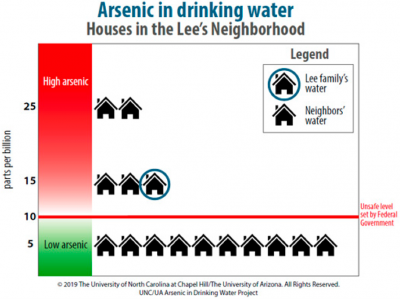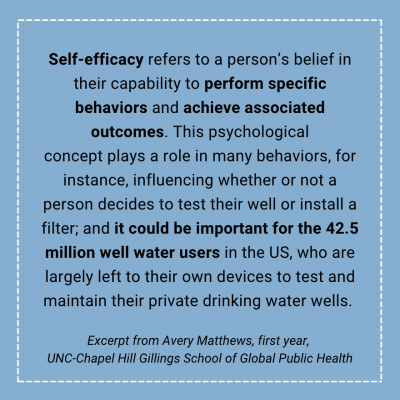Assessing environmental health literacy through a well water lens
A recent study by Kathleen Gray, PhD, leader of the UNC SRP’s Community Engagement Core (CEC), and researchers from the University of Arizona Southwest Environmental Health Sciences Center and the University of Kentucky Department of Preventative Medicine and Environmental Health, used toxic metals contamination of well water as the basis for exploring factors that influence environmental health literacy (EHL).

Dr. Kathleen Gray
EHL refers to the combination of knowledge, skills, and abilities that enable people to use environmental data to make health-protective decisions. When considering well water contamination, for instance, the EHL of well users could encompass any of the following:
- Their awareness of potential well water contaminants
- Their understanding of how exposure to contaminants in water could lead to negative health impacts
- Their awareness of options to reduce or eliminate contaminants
- Relevant skills that support well water quality, ranging from sample collection and interpretation of well test results to filter installation and maintenance
The study explored the EHL of 47 participants, including undergraduate students and residents of NC communities with contaminated well water, using a hypothetical scenario of a family whose well water was contaminated with arsenic. In addition to the scenario, the instrument developed for this study (referred to as WEHL, for Water EHL) included several components, including a hypothetical well water report (pictured below), a handout with general information about arsenic and associated health effects, and a series of questions about actions the family could take.

Hypothetical well test report provided to participants with hypothetical family survey.
Findings suggested adequate health literacy and EHL overall, yet when evaluated separately community residents’ WEHL scores were lower than those of the student group. These differences raised questions about which variables may be influencing them and led to further analysis which showed that both groups answered similar questions incorrectly – specifically regarding route of exposure and vulnerable populations. In addition, open discussion with each of the groups revealed differing levels of knowledge regarding potential well water contaminants.

A similar trend surfaced when looking at the self-efficacy findings. Both groups reported moderate to high certainty about their abilities to take action, yet when the data was analyzed by group there were significant differences. Notably, cost of testing and treatment and distance were limiting factors for the student group. This finding is interesting as income and transportation constraints experienced by students may mimic those of low-income populations and suggest important areas of focus for interventions.
Comparing the student group with the community residents also shed light on assessment tools. While analyzing their data, the project team discussed what it means to be environmentally health literate and how assessment tools themselves could influence findings.
Gray explains, “We realized a lot of the assessment tools look like tests that you encounter in school classrooms, and that structure could be limiting our understanding of where people are in terms of their knowledge, skills, or readiness to act on environmental information.”
The CEC, which Gray leads, works to foster environmental health literacy by partnering with community-based organizations, SRP researchers, and policy experts to develop locally relevant solutions to toxic metals contamination of well water.
 On well water testing in general, Gray explains “These results are really important to people. It’s the drinking water in their homes, so they’re highly motivated to understand the results; but we realized that we didn’t know enough about barriers to understanding test results and we knew even less about barriers to treatment.”
On well water testing in general, Gray explains “These results are really important to people. It’s the drinking water in their homes, so they’re highly motivated to understand the results; but we realized that we didn’t know enough about barriers to understanding test results and we knew even less about barriers to treatment.”
The team concluded that the tools currently being used to measure EHL can be a useful starting point for educators wanting to better understand their audience’s existing knowledge, but that more research is needed to understand how context-specific skills, self-efficacy, and social constraints may influence EHL, particularly among diverse audiences.
Discussing how this research could impact future projects, Gray says “I hope that this work helps us understand and tap into the skills and knowledge that our community partners bring to the table. I also hope it helps us better understand treatment constraints, so we can be as effective as possible in helping people remove contaminants identified in their drinking water.”
